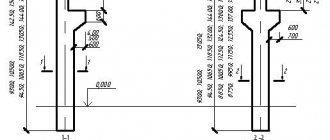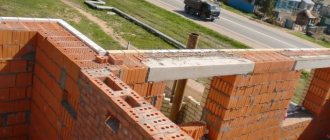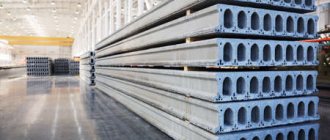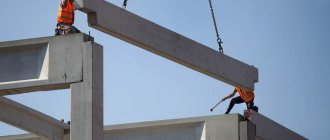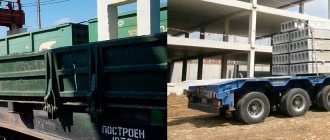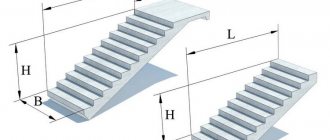Purpose
Figure 1. Reinforced concrete columns
The purpose of any reinforced concrete column is to perform a supporting function. Columns are used to strengthen various elements: from beams to arches and balconies. They are made of heavy concrete, and so that the finished product has great strength and can withstand maximum loads, the columns are reinforced with metal rods.
With the help of supporting elements, various objects are strengthened: from household to single- and multi-story. The use of columns is in demand wherever it is necessary to evenly divide the power load.
In a housing complex, columns take loads from the components above them. When constructing industrial facilities, support elements are placed across the area to support the floors and ensure the stability and safety of the building.
What problems does the installation of reinforced concrete columns solve?
Columns serve as an open support for ceilings, balconies, and terraces, taking on and transferring the load from these structural elements of the building to the foundation. They not only increase the operational life of the building, but also allow the implementation of many design solutions. Reinforced concrete pillars can serve as decorative and functional elements of entrance groups and interiors. In this case, they are supplemented with column supports, consoles, stucco molding, and milling.
Round and square columns, created from ready-made concrete products or constructed using monolithic technology, are used to strengthen and decorate buildings for industrial, administrative, residential and other purposes.
Reinforced concrete columns and their features
Precast concrete columns are made using reinforced concrete and giving the products a vertical shape. As a rule, they are used to construct a frame. The column consists of three elements:
- Head – accepts the mass of the higher structure.
- Rod – transfers the load to the lower part.
- Base – evenly distributes pressure and load.
The production of reinforced concrete columns is carried out from reinforced concrete, hence the name of these supporting elements. Compressed columns are distinguished:
- centrally, when structures take axial load;
- eccentrically, when the structures also take a bend.
Centrally compressed ones implement a supporting function, therefore they are used where only vertical load acts. In places where there is also an axial load, eccentrically compressed products are used.
General information
Columns, in essence, are supports that perform a load-bearing function, i.e. give the structure vertical rigidity. In addition, very often they also serve as a decorative element that can decorate both the facade of a building and the interior of the room.
It must be said that sometimes columns are used solely for decorative purposes. For example, columns made of polyurethane or even plasterboard are used to decorate the interior. Accordingly, they cannot perform any load-bearing function.
A casing structure, called a column, strengthens the walls of the well
There are also casing columns, which have nothing to do with support columns, since they are a pipe designed to strengthen the walls of boreholes. In addition, distillation columns are also used in the oil and alcohol industries. They are a cylindrical container in which the liquid is divided into fractions.
The rectification structure, also called a column, is used in the oil industry
Properties and characteristics
Figure 2. Reinforced concrete column
Each of the columns produced must meet strict standards and regulations. Products for the construction of certain buildings are selected based on the following criteria:
- number of floors of the house;
- purpose of the building;
- climate of the region, precipitation level;
- height of groundwater;
- calculated load.
Properties of reinforced concrete columns:
- increased resistance to external factors;
- ability to preserve properties when exposed to moisture;
- compliance with the characteristics stated in the documents;
- ability to withstand loads of various kinds;
- long service life;
- frost resistance.
The main property of each supporting element is its load-bearing characteristic. The larger it is, the lower the supports are placed, that is, for the bottom of the building, elements showing the highest indicator are used; as the object is erected upward, this parameter may decrease.
Normative documents
Before choosing and purchasing supporting elements, you should not only make the necessary calculations and find a reputable seller, but also find out the requirements for columns. Each unit of this product produced in factories must meet certain parameters, the list of which is regulated by GOSTs.
Important: before purchasing, you must study the documentation included with the product, which must confirm the product’s compliance with regulatory requirements.
Before releasing products for sale, they are carefully inspected by inspectors, and research is carried out to ensure the proper quality of the product.
Each reinforced concrete column is regulated by the following government documents:
- GOST 25628;
- GOST 18979;
Series:
- 04-1;
- 1.823.1-2;
- 1.423.1-3/88.
Standard series for reinforced concrete trusses
| No. | Number | Name | Notes |
| 1 | Series 1.063.1-4 | Reinforced concrete trusses with a span of 6; 9; 12; 15 and 18 m for covering buildings with an asbestos-cement roof slope of 1:4. | Look |
| 2 | Series 1.463.1-1/87 | Reinforced concrete trusses without braces with a span of 18 and 24 m for one-story buildings with a low-slope and pitched roof for the V snow region. | Look |
| 3 | Series 1.463.1-3/87 | Non-braced reinforced concrete trusses with a span of 18 and 24 m for one-story buildings with low-slope and pitched roofs. | Look |
| 4 | Series 1.463.1-15 | Reinforced concrete rafter trusses with a span of 12 m with a sagging lower chord for buildings covered with span-long slabs. | Look |
| 5 | Series 1.463.1-16 | Reinforced concrete segmental trusses for covering one-story industrial buildings with spans of 18 and 24 m (in formwork forms of the PK-01-129/78 series). | Look |
| 6 | Series 1.463.1-17 | Polygonal reinforced concrete trusses with a span of 18 and 24 m for roofing buildings with low-slope roofs. | Look |
| 7 | Series 1.463.1-19 | Pre-stressed reinforced concrete rafter trusses with a span of 12 m for roofing buildings with pitched roofs. | Look |
| 8 | Series PK-01-27 | Prefabricated reinforced concrete prestressed segmental trusses for roofing buildings with spans of 18, 24 and 30 m with truss spacing of 6.0 m. | Look |
| 9 | Series 1.463-3 | Reinforced concrete prestressed non-braced trusses with a span of 18 and 24 m for roofing buildings with pitched roofs. | Look |
| 10 | Series 1.466.1-5 | Reinforced concrete multi-wave shells of positive curvature measuring 18x24, 18x30 and 18x36 m from 3x6 m slabs. | Look |
| 11 | Series PK-01-129 | Prefabricated reinforced concrete prestressed segmental trusses for building roofs with spans of 18, 24 and 30 m with truss spacing of 6 and 12 m. | Look |
| 12 | Series PK-01-129/68 | Prefabricated reinforced concrete prestressed segmental trusses for building roofs with spans of 18, 24 and 30 m with truss spacing of 6 and 12 m. | Look |
Material of manufacture
Figure 3. Reinforced concrete columns
Reinforced concrete columns are produced from concrete grades M300-M600. Steel reinforcement makes the product stronger, provides long service life and resistance to external factors.
Columns are reinforced with steel, which guarantees safety and the ability to withstand shock and other loads on the material. The basic requirements for materials used for the manufacture of reinforced concrete columns are as follows:
- high speed of hardening of the concrete mixture;
- plasticity, safety and strength;
- the reinforcement must have high adhesion to the concrete mixture and be weldable;
- the fittings must be resistant to corrosion.
Standard series for reinforced concrete floor slabs
When designing floor slabs, the following series may be useful:
| No. | Number | Name | View via link |
| 1 | Series 1.065.1-2.94 | Reinforced concrete ribbed slabs 250 mm high for roofing buildings. | Look |
| 2 | Series 1.137.1-8 | Reinforced concrete hollow-core loggia slabs for residential buildings. | Look |
| 3 | Series 1.137.1-9 | Reinforced concrete balcony slabs for residential buildings. | Look |
| 4 | Series 1.138-3 | Reinforced concrete cornice slabs for residential and public buildings. | Look |
| 5 | Series 1.141.1-30 | Reinforced concrete hollow-core floor slabs. For sanitary facilities. | Look |
| 6 | Series 1.141.1-40s | Reinforced concrete hollow-core floor slabs, reinforced with At-V class steel rods, for the construction of residential and public buildings in areas with seismicity of 7, 8 and 9 points. | Look |
| 7 | Series 1.143.1-7 | Solid reinforced concrete floor slabs for residential buildings with transverse wall spacing of 3.0 and 3.6 m. | Look |
| 8 | Series 1.165.1-12 | Coating slabs and lightweight concrete trays for large-panel residential buildings with a warm attic and roofing made of rolled materials. Working drawings. | Look |
| 9 | Series 1.238.1-2 | Parapet reinforced concrete row and corner slabs for public buildings. Working drawings. | Look |
| 10 | Series 1.243.1-4 | Flat reinforced concrete slabs of length 80, 110, 130 and 160 cm, reinforced with welded mesh made of BP-I class steel. Working drawings. | Look |
| 11 | Series 1.442.1-1.87 | Reinforced concrete ribbed floor slabs 400 mm high, laid on crossbar flanges (modified design). | Look |
| 12 | Series 1.442.1-2 | Reinforced concrete ribbed floor slabs 400 mm high, laid on rectangular cross-section beams. | Look |
| 13 | Series 1.442.1-3 | Reinforced concrete ribbed slabs 500 mm high for floors of industrial buildings. | Look |
| 14 | Series 1.442.1-5.94 | Reinforced concrete ribbed floor slabs 400 mm high, laid on rectangular cross-section beams. | Look |
| 15 | Series 1.465.1-15 | Reinforced concrete ribbed slabs measuring 3x12 m for covering one-story industrial buildings. | Look |
| 16 | Series 1.465.1-16 | Reinforced concrete ribbed slabs measuring 1.5x12 m for covering one-story industrial buildings. | Look |
| 17 | Series 1.465.1-17 | Reinforced concrete ribbed slabs measuring 3x6 m for covering one-story industrial buildings. | Look |
| 18 | Series 1.465.1-18 | Complex coating slabs for industrial buildings. | Look |
| 19 | Series 1.465.1-19 | Small-sized reinforced concrete slabs for covering one-story industrial buildings. | Look |
| 20 | Series 1.465.1-20 | Reinforced concrete ribbed slabs measuring 1.5x6 m for covering one-story industrial buildings. | Look |
| 21 | Series 1.465.1-21.94 | Reinforced concrete ribbed slabs measuring 3x6 m for covering one-story industrial buildings. | Look |
| 22 | Series 1.041.1-5 | Hollow-core floor slabs for interspecific purposes. | Look |
| 23 | Series 1.042.1-2 | Prefabricated reinforced concrete floor slabs of the “TT” and “T” types for multi-storey public and industrial buildings. | Look |
| 24 | Series 1.042.1-5.94 | Prefabricated reinforced concrete ribbed slabs 300 mm high for floors of multi-storey public buildings, production and auxiliary buildings of industrial enterprises. | Look |
| 25 | Series 1.141.1-32с | Reinforced concrete hollow-core floor slabs, reinforced with rods made of steel of class A_IV and At-IVC, for the construction of residential and public buildings in areas with seismicity of 7, 8 and 9 points. | Look |
| 26 | Series 1.141.1-39 | Lightweight hollow-core slabs of reduced height for the floors of manor houses. | Look |
| 27 | Series 1.041.1-3 | Prefabricated reinforced concrete hollow-core floor slabs of multi-storey public buildings, production and auxiliary buildings of industrial enterprises. | Look |
| 28 | Series 1.400-11/91 | Recommendations for the use of prefabricated reinforced concrete standard slabs in coverings of industrial buildings. | Look |
| 29 | Series 2.140-2m | Details of floors of residential and public buildings for climatic region I. | Look |
| 30 | Series 2.140-5c | Floor assemblies for residential and public buildings erected in areas with seismicity of 7, 8 and 9 points. | Look |
Reinforced concrete columns and their types
It was noted earlier that columns are used for the construction of various objects, therefore these products are divided into types according to different parameters.
Appearance
By appearance, the columns are divided into:
- console;
- non-console.
Cantilever-type products are used when installation is required using overhead cranes. If it is necessary to carry out installation without cranes, then a non-cantilever type is used.
Cross section
Supports according to this parameter are divided into:
- rectangular;
- square;
- round.
To choose the right type, it is necessary to take into account the load and the intended purpose of the product. For example, in places where the decorative function plays a major role, products with a round cross-section are used.
Important: reinforced concrete columns may have so-called “shelves”, which are required for high-quality and reliable installation of floors.
Manufacturing technology
According to GOST standards, supporting elements are created in two ways:
- Monolithic concreting is a technique that allows the production of columns during construction work.
- Prefabricated reinforced concrete columns are produced on an industrial scale and delivered to the construction site. Then the builders use equipment to fasten it.
Location
Reinforced concrete columns by location are:
- average;
- extreme;
- façade;
- decorative.
It should be noted that decorative columns are used as decoration and carry almost no load. However, they can be replaced with facade elements - they will act as a support and at the same time perform a decorative function.
Middle and outer supports are used to strengthen the floors. The difference between them is how many fastenings the support implies. Thus, the outer columns have only one protrusion, and the middle ones have two.
Important: the use of reinforced concrete columns allows you to shorten the period of construction work and reduce the costs of constructing an object, without causing damage to the characteristics of the building.
Reinforced concrete columns
Externally, the support looks like an elongated pillar with a rectangular cross-section. It consists of the following parts: head, rod, base.
Classification
There are several types of columns. When creating a project, the required element is selected. At the same time, attention is paid to the aggressiveness of the external environment in which the object will be operated, the seismic situation, the level of load on the element, hydrophobicity and frost resistance.
There is also a classification according to the area of application of supports. Their designs vary depending on the floor on which the products are installed. There are top, middle, bottom, jointless columns.
Manufacturing
Columns of this type can be produced according to one of 12 albums of standard products. In some cases, the manufacturer works according to a special customer drawing. Also, building elements must comply with GOSTs “Reinforced concrete columns for multi-story buildings” and “Reinforced concrete columns for single-story enterprise buildings.”
Products are manufactured using formwork. A reinforcement frame is installed in the formwork, and the concrete mixture is poured. The reinforcement can be non-prestressed or pre-stressed. In the first case, thermomechanically reinforced rods, hot-rolled rods, smooth reinforcement, and reinforcing wire are used. In the second, reinforced At-IV C rods, hot-rolled A-V rods, and A-III rods are used.
Concrete corresponds to grades M300-M600. Tension release of the reinforcement frame onto the concrete mass is carried out after it reaches the design transfer strength.
Marking
The marking is written on the visible side of the column, closer to the bottom end, on the side. In the first positions, letters indicate the type of support:
- K - frames of buildings without cranes;
- KS - similar to “K”, but with rafter roof structures;
- KK - frames with taps;
- KKS - frames with cranes and rafter structures;
- KKP - frames with taps and passages;
- KR - frames with manual taps;
- KF - half-timbered supports.
After the abbreviation, the bearing capacity number and reinforcement class are indicated.
Delivery of reinforced concrete columns
Delivery of columns is carried out by our own transport to Moscow, the region and other regions of Russia! Delivery estimates can be ordered in the Delivery section.
According to GOST, heavy cargo can be transported only in a horizontal position in special vehicles. When loading/unloading, it is prohibited to move several pieces at a time. Exception: rigging work with special devices, where lifting several products at the same time is allowed.
When storing in open ground, a pad with a thickness of at least 10 cm is placed at the base of the stack; a drain for water is required.
Reinforced concrete columns price in Moscow
Reinforced concrete columns price per piece. The price depends on their size, thickness, presence/absence of strengthening additives, reinforcement. In order not to overpay for the goods, it is advisable to order directly from the manufacturer at the PSK Perspektiva plant. This way you will receive certified reinforced concrete products with a laboratory report and at the best cost.
Our company can offer you the optimal balance between quality and cost.
You can request our price list and place an order in the section of the site that interests you.
Buy reinforced concrete columns at the concrete goods plant
It is profitable to buy reinforced concrete columns without intermediaries at. We are now increasing our production capacity and looking for new reliable partners.
Calculation features
The choice is made only after a preliminary calculation of the loads has been made. For example, for production, support elements filled with B15-B25 concrete are used, and for low-rise buildings - B30.
The cross-sectional area is calculated using the formula F/Rb=A, where:
- F – means compression force;
- Rb – compressive strength.
Having calculated the area, you can begin to calculate other parameters, but usually a special technique is used for this, since the calculations are complex and the likelihood of making a mistake is high.
Reinforced concrete columns - installation stages
When constructing low-rise buildings, the supporting elements are installed entirely, but if the length of the column is large, then they are delivered to the site disassembled and then assembled. Installation is carried out using different methods, for example, in the base glass.
Most often, the supporting elements are installed on a glass-type base. Pouring concrete is done in advance, taking into account the length of the product, on which the width of the concrete layer will depend.
Before installing the columns, make markings in the required places of the base. The installation is carried out “in weight”. Before pouring concrete, the supports are secured with wedges.
Important: during installation, you must strictly follow the standards specified in SNiPs. Until the concrete mixture has completely hardened, it is prohibited to lower other structural elements onto the columns.
While the support is in a “suspended state,” one of the faces is welded. The final installation is carried out using special braces. As soon as the column is installed and inspected for correct installation, the contact area between the support and the column is welded. And only after that the concrete mixture is applied to the outside.
Important: installation of reinforced concrete supports is not particularly difficult if the products used meet the requirements and meet the declared characteristics.
How to choose the right reinforced concrete columns
Before installing reinforced concrete columns, they must be purchased. You can make the right choice based on the following indicators:
- those. support element diagram;
- height and number of floors of the building;
- section volume;
- location of the building.
Important: you should purchase columns only from a trusted manufacturer, so as not to later eliminate the consequences of using a low-quality product. There is no point in saving on supporting elements - it is better to spend money, but be sure that the product complies with GOST.
Reinforced concrete columns are irreplaceable supporting elements that are used for the construction of various objects. By making the correct calculations and taking into account all the nuances and features, you can build a safe, strong and durable building.
